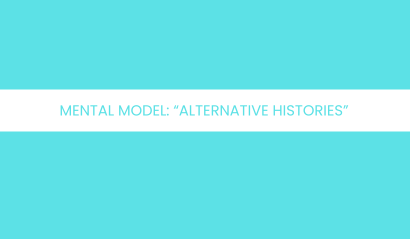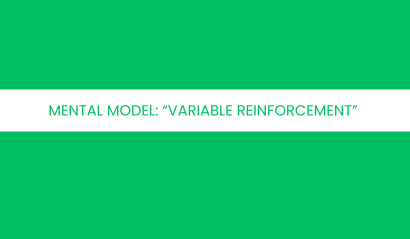Mental Model: Do Something Bias
Have you ever found yourself in a situation where doing nothing felt like the worst possible option, even if taking action wasn’t necessarily the best course? This instinct to take action, regardless of whether it’s rational, is known as Do Something Bias. It is a powerful cognitive bias that pushes us to act in the face of uncertainty, anxiety, or crisis—even when inaction might be the smarter choice.
In this article, we’ll explore the origins of Do Something Bias, how it manifests in different areas of life, and, most importantly, how to recognize and mitigate its effects to make more thoughtful and effective decisions.
The Origins of Do Something Bias
The tendency to act rather than remain passive has deep evolutionary roots. In prehistoric times, taking action was often the difference between life and death. When faced with a threat—such as a predator lurking in the bushes—fleeing or fighting were instinctual responses that increased the chance of survival. Those who hesitated or did nothing risked becoming prey.
Over time, this impulse became ingrained in human psychology. Acting in response to a problem gives us a sense of control, even if the action itself is ineffective. In modern society, where many problems are complex and require careful deliberation, this bias can lead to impulsive decisions that are not in our best interest.
How Do Something Bias Works
Do Something Bias is primarily driven by psychological discomfort. When faced with a problem, especially one that causes stress or uncertainty, we experience cognitive dissonance—a mental discomfort caused by conflicting thoughts or feelings. Taking action, even if it’s arbitrary, relieves this discomfort and provides a sense of agency.
However, this bias can lead us to make hasty decisions, waste resources, or even make matters worse. It often overrides rational thought and prevents us from carefully weighing the consequences of our actions.
Key Psychological Factors Contributing to Do Something Bias:
- Fear and Anxiety: When faced with uncertainty or risk, acting immediately feels more reassuring than waiting.
- Social Expectations: Society often values action over inaction, leading to pressure to “do something” even when it may not be necessary.
- Overconfidence in Decision-Making: We may believe that immediate action will lead to a better outcome, even without proper analysis.
- Desire for Control: Taking action, even if it is ineffective, provides an illusion of control over a situation.
- Cultural and Organizational Norms: In workplaces and governments, leaders are often expected to respond to crises with swift action, even if a wait-and-see approach might be more effective.
Examples of Do Something Bias in Everyday Life
Do Something Bias appears in various aspects of life, from personal decision-making to business and politics. Let’s examine some common examples.
1. Finance and Investing
Investors often react impulsively to stock market fluctuations. If the market drops sharply, people panic and sell their investments to “do something” rather than wait for recovery. However, long-term investors know that markets fluctuate and that staying put is often the best strategy.
Example: During the 2008 financial crisis, many investors sold off their stocks in a panic, only to miss out on the recovery that followed in the years ahead.
2. Healthcare and Medicine
Patients often demand treatment, even when it’s unnecessary. Doctors may prescribe medications, perform procedures, or order tests that add little to no value, simply because patients expect action.
Example: Overprescription of antibiotics happens partly because patients insist on receiving something for minor illnesses, even when antibiotics won’t help.
3. Politics and Policy-Making
Governments often implement immediate policies after a crisis to show they are “doing something.” These knee-jerk reactions can lead to ineffective or even harmful policies.
Example: After terrorist attacks, governments may impose broad, restrictive security measures that erode civil liberties but do little to enhance actual safety.
4. Sports and Coaching Decisions
Coaches and managers in sports often make substitutions or change strategies, even when the best option might be to stick with the original plan.
Example: A soccer coach who makes unnecessary substitutions in the last few minutes of a match just to appear proactive, even if the current strategy was working fine.
5. Business and Leadership
In companies, leaders often initiate new policies or restructure departments just to appear decisive, even when analysis suggests maintaining the status quo would be more effective.
Example: A CEO who fires employees or changes company direction immediately after a dip in quarterly earnings, instead of analyzing the underlying issues.
How to Overcome Do Something Bias
Recognizing Do Something Bias is the first step in overcoming it. Here are practical ways to counteract this bias and make better decisions.
1. Pause and Reflect
Before taking action, take a step back and assess the situation. Ask yourself:
- What happens if I do nothing right now?
- Do I have enough information to make a decision?
- Am I acting out of fear or logic?
Taking a pause can prevent rash decision-making.
2. Evaluate Costs and Benefits
Consider the potential consequences of acting versus not acting. If taking action has more risks than rewards, inaction may be the better choice.
3. Seek Advice and Perspectives
Getting input from others—mentors, colleagues, or experts—can help provide a more balanced perspective and reduce impulsive decision-making.
4. Embrace Strategic Inaction
Sometimes, doing nothing is the smartest move. Strategic patience allows you to gather more information, let emotions settle, and make more informed choices.
5. Develop Decision-Making Frameworks
Using structured approaches like the OODA loop (Observe, Orient, Decide, Act) or the Eisenhower Matrix (urgent vs. important) can help ensure that actions are thoughtful rather than reactive.
6. Acknowledge the Bias and Challenge It
Being aware of Do Something Bias helps reduce its influence. Challenge your instincts by asking whether your urge to act is based on logic or impulse.
Conclusion
Do Something Bias is deeply ingrained in human psychology, pushing us to act even when it may not be necessary. While taking action is sometimes the right move, recognizing when inaction is the best action can lead to better outcomes in finance, healthcare, politics, business, and everyday life.
By cultivating patience, analyzing decisions carefully, and seeking external perspectives, we can learn to resist this bias and make more rational choices. The next time you feel an urgent need to “do something,” take a moment to reflect—sometimes, the best move is no move at all.







